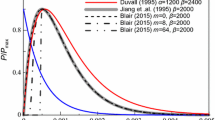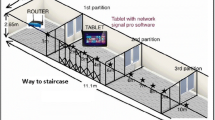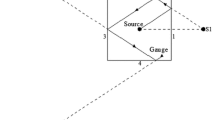Abstract
Blast waves generated from the muzzles of various weapons might have significant effects on the human body, and these effects are recognized as being more severe when weapons are fired indoors. The risk can be assessed by various criteria, such as waveform, exposed energy, and model-based types. This study introduces a prediction model of blast wave propagation for estimating waveform parameters related to damage risk assessment. To simulate indoor multiple reflections in a simple way, the model is based on the alternative image theory and discrete wavefront method. The alternative theory is a kind of modified image theory, but it uses the image space concept from a receiver’s perspective, so that it shows improved efficiency for indoor problems. Further, the discrete wavefront method interprets wave propagation as the forward movement of a finite number of wavefronts. Even though the predicted results show slight differences from the measured data, the locations of significant shock waves indicate a high degree of correlation between them. Since the disagreement results not from the proposed techniques but from the assumptions used, it is concluded that the model is appropriate for analysis of blast wave propagation in interior spaces.














Similar content being viewed by others
References
Hirsch, F.G.: Effects of overpressure on the ear a review. Ann. NY Acad. Sci. 152(1), 147–162 (1968). doi:10.1111/j.1749-6632.1968.tb11972.x
Altmann, J.: Acoustic weapons—a prospective assessment. Sci. Glob. Secur. 9(3), 165–234 (2001). doi:10.1080/08929880108426495
Branco, A.A.C.: Low frequency noise: a major risk factor in military operations. In: RTO AVT Symposium on Ageing Mechanisms and Control: Part A Developments in Computational Aero- and Hydro-Acoustics, RTO-MP-079(I), pp. 1–200 (2003)
Price, G.R.: Firing recoilless weapons from enclosure, U.S. army human engineering laboratory. Technical Memorandum 20–91, Aberdeen Proving Ground, MD (1991)
Price, G.R.: Firing from enclosures with 90 mm recoilless rifle: assessment of acoustic hazard, U.S. army human engineering laboratory. Technical Memorandum 11–78, Aberdeen Proving Ground, MD (1978)
Kong, B., Lee, K., Park, S., Jang, S., Lee, S.: Prediction of sound field from recoilless rifles in terms of source decomposition. Appl. Acoust. 88, 137–145 (2015). doi:10.1016/j.apacoust.2014.08.012
Ward, W.D.: Proposed Damage-Risk Criterion for Impulse Noise (Gunfire), Rept. of Working Group 57, NAS-NRC Committee on Hearing, Bioacoustics, and Biomechanics (1968)
MIL-STD-1474D: Design Criteria Standard—Noise Limits, U.S. Department of Defense (1997)
Pfander, F., Bongartz, H., Brinkmann, H., Kietz, H.: Danger of auditory impairment from impulse noise: a comparative study of the CHABA damage-risk criteria and those of the federal Republic of Germany. J. Acoust. Soc. Am. 67(2), 628–633 (1980). doi:10.1121/1.383886
Drullman, R.: Reconsideration of the effects of impulse noise. RTO Technical Report TR-017, Research and Technology Organization (2003)
Dancer, A., Franke, R.: Hearing hazard from impulse noise: a comparative study of two classical criteria for weapon noises (Pfander criterion and smoorenburg criterion) and the LAeq8 method. Acta Acust. 3, 539–547 (1995)
Desarnaulds, V., Monay, G., and Favarger, D.: Shooting noise regulation—review of various national practices. In: Proceedings of Internoise 98 (1998)
Chan, P.C., Kevin, H.H., Kan, K.K., Stuhmiller, J.H., Mayorga, M.A.: Evaluation of impulse noise criteria using human volunteer data. J. Acoust. Soc. Am. 110(4), 1967–1975 (2001). doi:10.1121/1.1391243
Garinther, G.R. and Hodge, D.C.: Small-rocket noise: hazards to hearing (advanced LAW program), U.S. army human engineering laboratories. Technical Memorandum 7–71, Aberdeen Proving Ground, MD (1971)
Murphy, W.J. and Kardous, C.A.: A case for using A-weighted equivalent energy as a damage Risk criterion, EPHB Report No. 350-11a, National Institute for Occupational Safety and Health (2012)
Patterson Jr., J.H.: Proposed new procedure for estimating allowable number of rounds for blast overpressure hazard assessment, U.S. Army Aeromedical Research Laboratory, USAARL Report No. 98-03, Fort Rucker, AL (1997)
ISO/FDIS 17201-2: Acoustics—noise from shooting ranges—part 2: estimation of muzzle blast and projectile sound by calculation, International Organization for Standardization (2005)
ISO/FDIS 17201-3: Acoustics—noise from shooting ranges—part 3: guidelines for sound propagation calculations, International Organization for Standardization (2008)
Jiang, Z., Takayama, K., Babinsky, H., Meguro, T.: Transient shock wave flows in tubes with a sudden change in cross section. Shock Waves 7(3), 151–162 (1997). doi:10.1007/s001930050072
Jiang, Z.: Wave dynamics processes induced by a supersonic projectile discharging from a shock tube. Phys. Fluids 15(6), 1665–1675 (2003). doi:10.1063/1.1566752
Bin, J., Kim, M., Lee, S.: A numerical study on the generation of impulsive noise by complex flows discharging from a muzzle. Int. J. Numer. Methods Eng. 75(8), 964–991 (2008). doi:10.1002/nme.2291
Kong, B., Lee, K., and Lee, S.: An alternative image theory for indoor sound propagation. In: Proceedings of Internoise 2012 (2012)
Kong, B., Jung, S., Son, E., Lee, S., Song, K.: Interior analysis of impulse noise from weapons in a perspective on damage risk using the alternative image theory, AIAA 2013-2031. In: Proceedings of 19th AIAA/CEAS Aeroacoustics Conference (2013). doi:10.2514/6.2013-2031
Di, X., Gilbert, K.E.: An exact laplace transform formulation for a point source above a ground surface. J. Acoust. Soc. Am. 93(2), 714–720 (1993). doi:10.1121/1.405435
Kinsler, L.E., Frey, A.R., Copper, A.B., Sanders, J.V.: Fundamentals of Acoustics, Chap. 17, 4th edn. Wiley, New York (2000)
Hamernik, R.P., Hsueh, K.D.: Impulse noise: some definitions, physical acoustics and other consideration. J. Acoust. Soc. Am. 90(1), 189–196 (1991). doi:10.1121/1.401287
Friedlander, F.G.: The diffraction of sound pulses I. Diffraction by a semi-infinite plane. In: Proceedings of the Royal Society of London A: Mathematical, Physical and Engineering Sciences, vol. 186, no. 1006, pp. 322–344 (1946). doi:10.1098/rspa.1946.0046
Morfey, C.L.: Dictionary of Acoustics. Academic Press, London (2001)
Pierce, A.D.: Acoustics: An Introduction to Its Physical Principles and Applications, 1989th edn. Acoustical Society of America, New York (1991)
Tam, C.K.W.: Computational Aeroacoustics—A Wave Number Approach. Cambridge University Press, New York (2012)
Tam, C.K.W., Webb, J.C.: Dispersion-relation-preserving finite difference schemes for computational acoustics. J. Comput. Phys. 107(2), 262–281 (1993). doi:10.1006/jcph.1993.1142
Acknowledgments
This work was supported by the Human Resources Development program (No. 20124030200030) of the Korea Institute of Energy Technology Evaluation and Planning (KETEP) grant funded by the Korea government Ministry of Trade, Industry and Energy. In addition, this research was also supported by the Basic Science Research Program through the National Research Foundation of Korea (NRF) funded by the Ministry of Education (2013R1A1A2011462).
Author information
Authors and Affiliations
Corresponding author
Additional information
Communicated by K. Kontis and A. Higgins.
Rights and permissions
About this article
Cite this article
Kong, B., Lee, K., Lee, S. et al. Indoor propagation and assessment of blast waves from weapons using the alternative image theory. Shock Waves 26, 75–85 (2016). https://doi.org/10.1007/s00193-015-0581-4
Received:
Revised:
Accepted:
Published:
Issue Date:
DOI: https://doi.org/10.1007/s00193-015-0581-4




